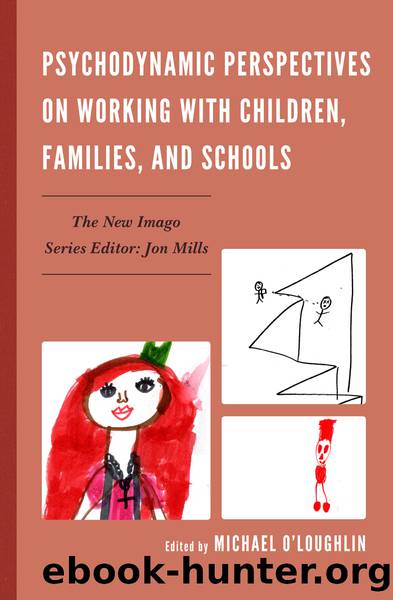Psychodynamic Perspectives on Working with Children, Families, and Schools by unknow

Author:unknow
Language: eng
Format: epub
ISBN: 9780765709226
Publisher: Rowman & Littlefield Publishers, Incorporated
THEORETICAL AND CLINICAL CONSIDERATIONS IN WORKING WITH CHILDREN AND MOTHERS
Differentiating between a childâs acting out as pure limit-testing, appropriate to the age, or as a communication that cannot be verbalized, is a skill that can be developed with some coaching for parents who are amenable to feedback in this area. As grown-ups, we may take for granted the ability to present ourselves adaptively to the various people and situations we encounter. This may even be seen as a sort of âhealthy splitting,â which comes increasingly under our control as we mature. For children this is not such an easy task. Conscious splitting-off of affects for the sake of survival has its price, but children do not always have an alternative. It is very much in the repertoire of the âhealthyâ adult to protect bodily and psychological integrity through this adaptation. For this reason, children are dependent on adult caretakers to help with their âdemons,â their traumas and fears. Children may split off their affect in play or drawing, but, like firemen going into a fire, they cannot help having feelings about the trauma and stressors. In general, insecure parents find their childrenâs negative emotions difficult to handle. They often respond negatively with aggression or by turning away. They have trouble separating themselves from the childâs fear or anger and cannot âmetabolize itâ with their own processes in order to give feedback that could help the child master his or her fears.
In his article, âThe Psychoanalytic Theory of Play,â Robert Walder (1933) explores the function of play in relation to the playing child and the caregiving adult. He notes that âPlay, as a fundamental and purposeful phenomenon, is encountered only in children, that is, during a period of growth, in which the traumata of life touch the ascending limb of the vitality curveâ (Walder, p. 220). Walder implies the function of mastery in his exploration of the uses of play, but when trauma is involved, interpretation of the play by an accepting adult is important to the integration and abreaction of the traumatized feelings. His question is an interesting one: Why would a child play out a painful scene (such as going to the dentist) if play followed the âpleasure principleâ as fantasizing and wish-fulfillment dreams do? His answer is that âthis merging of reality and fantasy . . . makes possible the abreaction of an experience in playâ (Walder, p. 221). It is the adult whom Walder feels is in âthe position to help the child obtain this kind of abreaction.â In a phrase that seems to predict Winnicottâs thinking in Playing and Reality (1971), Walder says âthe antithesis of play is reality, not seriousness.â (Walder, 1933, p. 223).
Attachment issues play a major role in the interface between the parentâs and childâs ability to cope with disruptions and trauma. If a parent has only marginally worked through his or her own attachment issues from childhood, the parent might have a âblind spotâ with respect the childâs attachment needs and difficulties.
Download
This site does not store any files on its server. We only index and link to content provided by other sites. Please contact the content providers to delete copyright contents if any and email us, we'll remove relevant links or contents immediately.
Through Windows of Opportunity : A Neuroaffective Approach to Child Psychotherapy by Marianne Bentzen; Susan Hart(921)
Overcoming ADHD Without Medication : A Guidebook for Parents and Teachers by Children and Natural Psychology Association for Youth; Children The Association for Youth(857)
Out of the Mainstream: Helping the Children of Parents with a Mental Illness by Loshak Rosemary;(854)
Delphi Collected Works of Sigmund Freud (Illustrated) by Sigmund Freud(613)
The Noom Mindset by Noom(571)
The 48 Laws of Mental Power: Overcoming Trauma and Building Mental Strength by Victor O. Carl(525)
The Psychology of Media and Politics by George Comstock & Erica Scharrer(468)
MANIPULATION & MIND CONTROL: The Persuasion Collection: Dark Psychology Secrets, Analyze & Influence People with Nlp. How to learn Reading Friends and Develop Body Language Skills. by ROBERT TOWER(449)
Sigmund Freud by Janet Sayers;(448)
It's nobody's fault: new hope and help for difficult children and their parents by Harold Koplewicz(422)
Behold the Monster by Jillian Lauren(421)
The Hypnotic Coach: A Conversational Hypnotherapy Tool Kit by Marion Jess(404)
Directions in Technical Writing and Communication by Gould Jay R.;(399)
Totem and Taboo: Some Points of Agreement between the Mental Lives of Savages and Neurotics by Sigmund Freud(396)
Mastering Flow: Perform Better, Experience More Joy, and Live a Happier Life by Nils Salzgeber(376)
THE PSYCHOLOGY OF ENTREPRENEURSHIP; New Perspectives by Michael M. Gielnik; Melissa S. Cardon; Michael Frese(373)
Mind Hacking Secrets and Unlimited Memory Power: 2 Books in 1: Learn How to Improve Your Memory & Develop Fast, Clear Thinking in 2 Weeks + 42 Brain Training Techniques & Memory Improvement Exercises by Sharp Scott(348)
Positive Psychology Across the Lifespan; An Existential Perspective by Piers Worth(346)
The Modern Young Man's Guide to Manhood by Wayne Walker(335)
